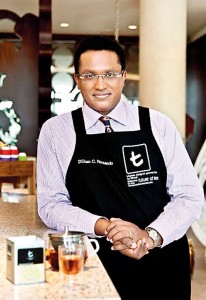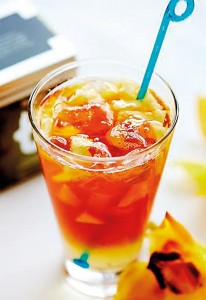Celebrating tea
In the 1700s, it was the afternoon meal of the working man complete with cakes, scones, toast and of course, a cup of tea. Almost 400 years later “High Tea” has travelled beyond the Englishman’s drawing room and found itself becoming an opportunity to dress up and gorge oneself to the point of being uncomfortably stuffed on a tempting buffet. The actual cup of tea, meanwhile, has come to think of it, become insignificant amongst the scones, sandwiches and cakes.

Dilhan Fernando
Leading tea company Dilmah is looking to change this. “Tea is various, diverse and adaptable to any culinary style, food or mixology,” stresses Marketing Director of Dilmah, Dilhan Fernando. Their vision of celebrating the tradition of tea alongside gastronomical innovation is embodied in the Dilmah Real High Tea Challenge which takes place this week, putting Sri Lanka on the world stage as competitors travel here from some 14 different countries to vie for the honours.
The competition saw its beginnings in 2007, in partnership with WACS (World Association of Chefs Society), the global authority on food. Over the last seven years it has gone from challenging 27 local culinary giants to a global challenge which will unfold on July 1 with over 800 contestants from around the world hoping to revolutionize the concept of High Tea.
“There were so many styles of preparation but our task was to see how tea was integrated,” says Dilhan, one of the international judges of the contest who also judged the competition at national level. Having tried everything from South American empanadas to slow-cooked Indonesian rendang, what they as judges look for is the harmony of flavours in the pairing of food with tea, he says.
What fascinates Dilhan most about Camellia sinensis as he fondly refers to it, is the complexity behind the plant itself. On a sensory level, tea is diverse as it is flavourful, he elaborates, and can complement a variety of meat and fish in the same way wine would. But it’s not something you would see in a restaurant “no one would ask you what kind of tea you would like with your meal” he adds, a still overlooked notion they hope to change with the Real High Tea Challenge.
In addition to its diversified flavour palatte are the obvious health benefits that come with the herb which is packed with phytochemicals and polyphenols.
To be held from July 1st to 3rd at the Hilton Colombo Residence, the Dilmah Real High Tea Challenge will be a smorgasbord of tea, skilfully incorporated in a multitude of culinary techniques. Hot teas, cold teas, tea cocktails and mocktails and infusions along with pairings will be some of the many ways in which the key ingredient will be used while still being the hero of the dish.
Mouth-watering presentations, the sharp singular fragrance of tea along with obvious curiosity and raised eyebrows accompany many a dish as chefs try to surpass their own skill, imagination and the usual classic culinary combinations. The winning touch or rather the element that  makes or breaks the competitor is however, the simplest. “Surprisingly, not many people can make a good cup of tea,” admits Dilhan. It’s why Dilmah places a lot of effort and detail even in the water used in their t- lounges for brewing. At the end, it literally boils down to how good the tea used is, with emphasis given to the sustainable use of tea and ingredients.
makes or breaks the competitor is however, the simplest. “Surprisingly, not many people can make a good cup of tea,” admits Dilhan. It’s why Dilmah places a lot of effort and detail even in the water used in their t- lounges for brewing. At the end, it literally boils down to how good the tea used is, with emphasis given to the sustainable use of tea and ingredients.
Dilhan remembers the beginnings of the High Tea Challenge – “People thought we were nuts” he says, when they first pitched the idea. Seven years and 800 competitors later, he is continually impressed by the creativity and innovation the contestants bring to the table.
Describing his ideal of what a high tea should be, he says “it needs to respect tradition” looking back to the celebratory atmosphere, conversation and fellowship one associates with a High Tea. “It’s the closest thing we have to a tea ceremony” he adds, emphasizing the need to make it a gastronomical event. The precision in creating the perfect setting and menu will invariably depend on the guests. For Dilhan, it comes down to the mood and ambience as well. “If I think in terms of Sri Lanka, I would take into account the afternoon heat,” he explains, preferring a cold infusion, a savoury, a sweet, rather than the standard cucumber sandwiches, reminiscent of English tea-time almost three centuries ago.
With less than a few days for what is described as the biggest tea revolution, the competition, while being an opportunity to re-invent the concept of a high tea is a full circle back to its very roots.“We aren’t the craftsmen, just merely the facilitators,” Dilhan says – looking forward to the moment when nature and the simple herb with a fascinating complexity will take centre stage.


